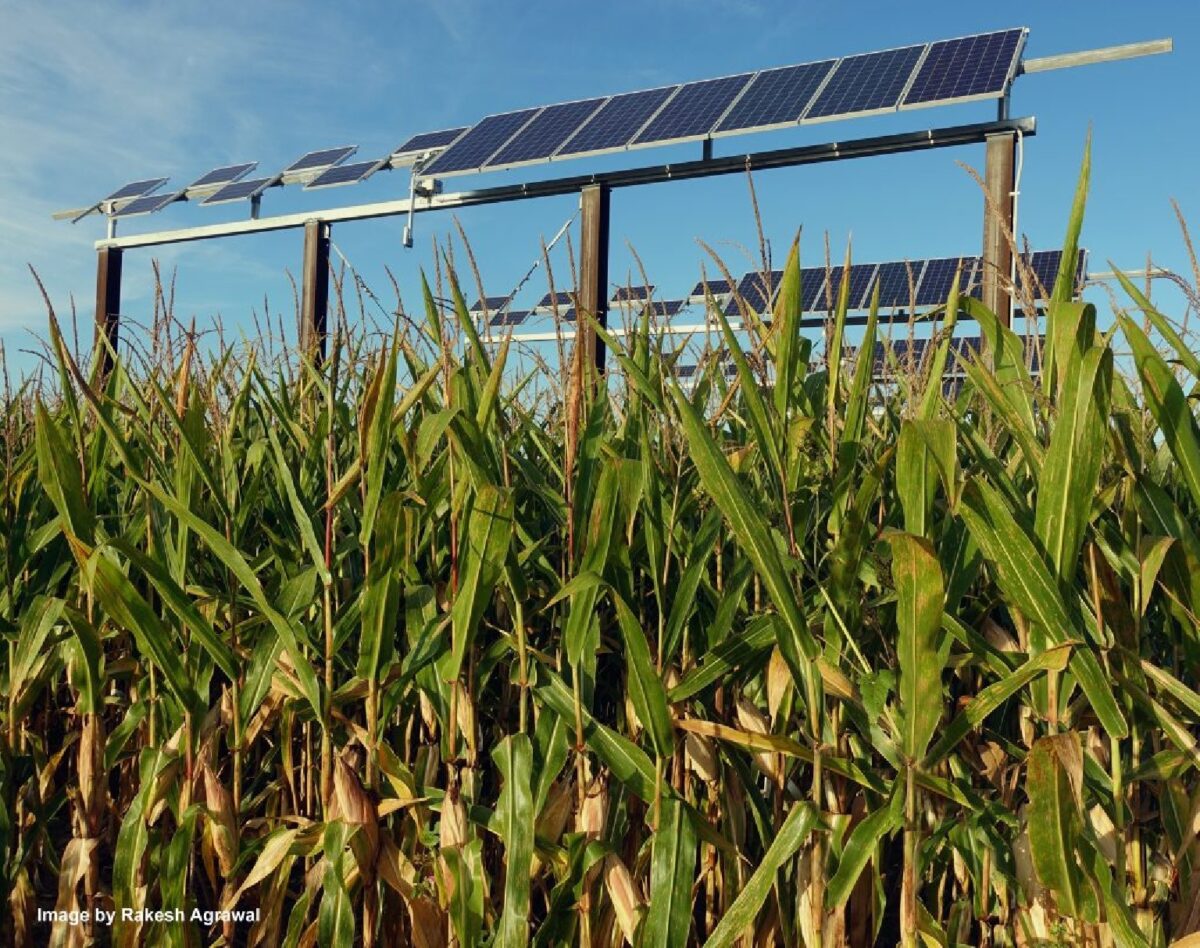A team of researchers from Purdue University have found agrivoltaics have the potential to increase energy production and reduce carbon emissions while having a minimal impact on crop production.
In the research paper “The viability of photovoltaics on agricultural land: Can PV solve the food vs fuel debate?,” available in the Journal of Cleaner Production, the team analyzed five scenarios featuring corn croplands in the midwest region of the United States.
The first is the baseline scenario, with corn grown over the whole area. The second features a traditional solar system installed on 25% of the area, replacing the corn crop. The other three scenarios feature agrivoltaics with corn growing beneath them, with an estimated 5.5% of the land occupied by solar structures and unavailable for crop growth. A full solar panel density is used in the third system, followed by half and a quarter panel density in the fourth and fifth systems.
The researchers compared these five systems across four metrics: the production of corn for use as food or animal feed, the production of energy in the form of bioethanol or electricity, the reduction of greenhouse gas emissions and the profitability for the farmer.
The highest food/feed production was achieved in the baseline system. The second system saw the amount of corn as food/feed drop by 25%, in proportion to the reduction in available land. Outputs from the agrivoltaic systems varied based on shaded boundaries, with an 11% reduction in corn available for food/feed recorded in the quarter solar panel density system when compared to the baseline system.
When compared to the baseline system, the traditional photovoltaic system and quarter-density agrivoltaic system raised end-use energy production from less than 2 MWh/ha/year to approximately 140 MWh MWh/ha/year. The half-density agrivoltaic system raised energy production to around 280 MWh/ha/year and the full-density agrivoltaic system raised energy production to approximately 560 MW/ha/year.
The researchers also found ethanol to have a minimal impact on the total energy production in systems two to five. “Therefore, there was no significant difference on overall energy outputs when considering the low shaded yield and high shaded yield boundaries of corn production,” said the team.
When calculating greenhouse gas reductions, the baseline system, with only ethanol as an energy source, had a reduction of less than 2 tonnes CO2-eq/ha/year. The other systems reduced emissions by hundreds of tonnes CO2-eq/ha/year, with the quantity in each “similarly trended with the number of solar panels that were incorporated into the entire treatment area”.
While the traditional photovoltaic system and the agrivoltaic system with a quarter density had effectively the same energy generation and greenhouse gas reduction, the research paper predicts higher corn yield for the agrivoltaic system because it allows for more crop growth and shading was minimized by large spacing between panels.
In the report’s conclusion, the researchers say agrivoltaics “can provide a viable strategy to ease the current tradeoff between energy production, greenhouse gas emissions, food production, and farm profitability.”
“Our analysis indicates that both photovoltaic systems and agrivoltaics can substantially increase energy production per hectare relative to the baseline where around 27% of corn is attributed to ethanol,” the researchers noted.
The researchers also explain that while the deployment of agrivoltaics may be impacted by high capital costs, this barrier could be overcome with policy support, especially when crop prices are highly volatile. They say associated costs should decrease as the technology develops, but warn more work needs to be done to ensure a better understanding of stakeholder needs and improved engineering to drive down costs while maximizing system outputs.
“Integrating photovoltaics into agricultural land offers greater potential for the production of renewable energy and reducing greenhouse gas emissions,” the paper says. “Our calculations show that if there is no ethanol demand the amount of corn available as a food and animal feed resource can actually be increased even when solar panels are integrated, relative to the amount available under the conditions of ethanol demand and no photovoltaic integration. In this view, agrivoltaic technologies provide a viable solution to the food versus fuel debate, allowing large amounts of energy to be produced with minimal impact on corn as a food/feed resource.”
Earlier this year, Purdue University researchers created a novel model for assessing the growth of corn in agrivoltaic facilities by proposing a spatiotemporal shadow distribution model to optimize crop yield and power production.
This content is protected by copyright and may not be reused. If you want to cooperate with us and would like to reuse some of our content, please contact: editors@pv-magazine.com.








By submitting this form you agree to pv magazine using your data for the purposes of publishing your comment.
Your personal data will only be disclosed or otherwise transmitted to third parties for the purposes of spam filtering or if this is necessary for technical maintenance of the website. Any other transfer to third parties will not take place unless this is justified on the basis of applicable data protection regulations or if pv magazine is legally obliged to do so.
You may revoke this consent at any time with effect for the future, in which case your personal data will be deleted immediately. Otherwise, your data will be deleted if pv magazine has processed your request or the purpose of data storage is fulfilled.
Further information on data privacy can be found in our Data Protection Policy.